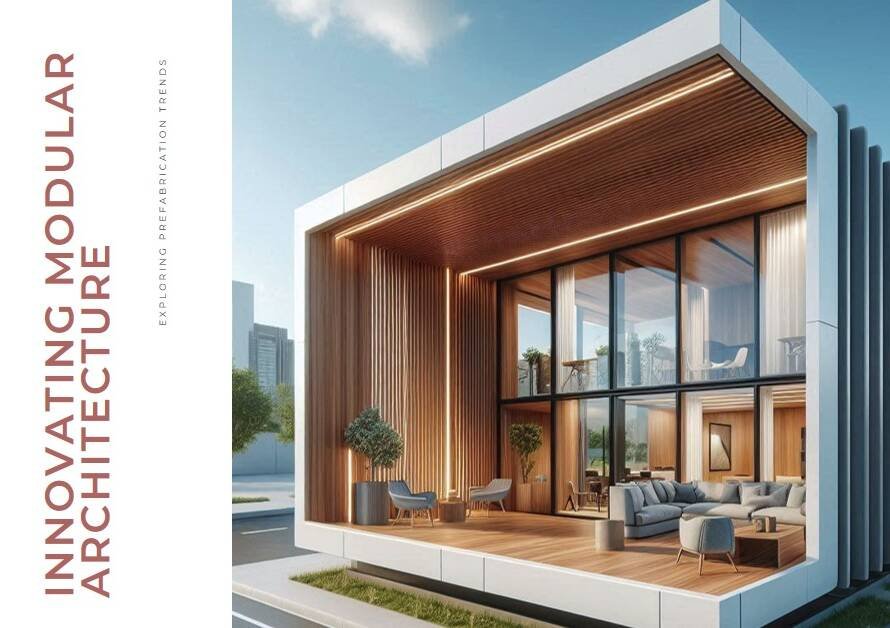
Table of Contents
What is 3D Printing in Architecture?
3D printing in Architecture, also known as additive manufacturing, has revolutionized numerous industries, and architecture is no exception. In the realm of architecture, 3D printing refers to the use of this cutting-edge technology to create physical models or even full-scale structures. The technique involves layering materials such as concrete or thermoplastics in a precise manner based on digital designs. Unlike traditional methods of construction, where building components are manufactured individually and then assembled on-site, 3D printing allows for the creation of complex architectural geometries in one continuous process.
One major advantage of 3D printing in architecture is its ability to minimize waste. Traditional construction often generates significant amounts of material waste during fabrication processes that require cutting or molding. With 3D printing, material usage can be optimized through computer-aided design (CAD), which calculates the minimum required amount for each layer. This not only reduces costs but also helps architects adopt more sustainable practices by minimizing environmental impact.
Moreover, with 3D printing technology being capable of producing intricate designs with subtle variations effortlessly, architects are now able to unleash their creativity like never before. Previously impractical designs due to logistical constraints can now come to life thanks to additive manufacturing techniques. This opens up possibilities for unique shapes and structures that push architectural boundaries and challenge conventional perceptions of space and form. With 3D printers becoming increasingly accessible and affordable, its integration into architecture promises an exciting future full of endless possibilities waiting to be explored.
Brief history of 3D printing technology
3D printing, also known as additive manufacturing, has rapidly emerged as a groundbreaking technology with numerous applications across various industries. However, its origins can be traced back to the 1980s when American engineer and inventor Chuck Hull developed the first ever 3D printed object – a small plastic cup. This breakthrough initiated a wave of innovation within the field and set the stage for future advancements.
In those early years, 3D printing primarily focused on developing prototypes and creating small-scale objects. It wasn’t until the turn of the century that this remarkable technology started gaining recognition in architecture and construction. Architects realized its potential to revolutionize their profession by enabling them to create complex designs that were previously impossible using traditional methods.
As time passed, 3D printing technology became more accessible and affordable, leading to its widespread adoption across industries beyond architecture. Today, it is used in healthcare for creating prosthetics, dental implants, and even human organs. The automotive industry employs 3D printing for rapid prototyping and custom part production. Even aerospace companies are harnessing this technology to manufacture lightweight yet durable parts for spacecraft. The possibilities seem limitless as researchers continue exploring new materials and techniques to refine 3D printing capabilities further.
Applications of 3D printing in architecture
One of the most exciting applications of 3D printing in architecture is the ability to create complex, intricate designs that were previously impossible with traditional construction methods. Architects can now easily bring their wildest ideas to life by utilizing this innovative technology. For example, 3D printing allows for the creation of unique and personalized building components, such as facades or column capitals, adding a touch of exclusivity to each project.
Moreover, 3D printing is revolutionizing the way architects approach sustainable design. With its ability to create intricate geometries and optimize material usage, 3D printing offers endless opportunities for creating energy-efficient structures. By using lightweight structures with hollow interiors, architects can reduce the overall weight and environmental impact of buildings while maintaining structural integrity.
Another fascinating use case is in disaster relief and temporary housing solutions. After natural disasters or humanitarian crises, providing shelter quickly becomes a top priority. In these situations, 3D printing can be instrumental in rapidly producing affordable and durable housing units on-site. The speed at which these structures can be printed allows for quick deployment and immediate relief for affected populations.
In conclusion, 3D printing presents numerous exciting applications within the field of architecture that were previously unimaginable. From enabling intricate designs to promoting sustainability and aiding in disaster relief efforts, this revolutionary technology has limitless potential for reshaping the industry in profound ways. As architects continue to push boundaries with their designs aided by 3D printing capabilities
Benefits of using 3D printing in architecture
One of the biggest benefits of using 3D printing in architecture is the ability to prototype and iterate designs much more efficiently. Traditionally, architects had to rely on manual model making techniques, which could be time-consuming and expensive. With 3D printing, architects can quickly translate their digital designs into physical prototypes, allowing them to visualize and test different ideas before settling on a final design.
In addition to accelerating the design process, 3D printing also enables architects to create complex geometries that would be difficult or even impossible to achieve with traditional construction methods. This opens up a whole new world of possibilities for architectural forms and structures. From intricate facades to parametric designs, 3D printing allows architects to push the boundaries of creativity and create truly unique buildings.
Moreover, using 3D printing in architecture can lead to significant cost savings in terms of materials and labor. By utilizing additive manufacturing techniques, architects can optimize resource usage by only adding material where it is required. This not only reduces waste but also minimizes construction time as there is less need for manual assembly. Furthermore, due to increased accuracy in fabrication processes through 3D printing technology, there is a reduced chance of errors compared to traditional construction methods.
In conclusion, the benefits of using 3D printing in architecture are numerous: quicker prototyping and iteration processes; limitless design possibilities; and cost savings through optimized resource usage and increased fabrication accuracy
Challenges and limitations of 3D printing in architecture
One of the major challenges faced by 3D printing in architecture is the size limitation of the printers. Most commercially available 3D printers have a limited build volume, which restricts the size of objects that can be printed. This becomes particularly problematic when it comes to printing large-scale architectural structures and buildings. While smaller elements like building components and intricate decorative features can be easily printed, creating entire buildings with current technology remains a significant hurdle.
Another limitation of 3D printing in architecture is the material selection and durability issue. Currently, most 3D-printed architectural projects are made from various types of plastic or resin materials, which may not provide sufficient strength or long-term resistance to weathering. Furthermore, these materials often lack fire resistance and may require additional treatments or coatings to meet safety regulations. Finding suitable materials for large-scale construction that meet all necessary requirements has proven to be a major challenge for architects utilizing 3D printing technology.
Additionally, there are regulatory challenges associated with using 3D-printed parts in architecture. Building codes and standards have yet to catch up with this emerging technology, making it difficult for architects to navigate through legal requirements when incorporating 3D-printed elements into their designs. Moreover, there is limited knowledge among professionals regarding the structural integrity and load-bearing capacity of 3d-printed construction components, leading to hesitation in implementing this innovative technology on a larger scale.
Future possibilities for 3D printing in architecture
As 3D printing technology continues to advance, the possibilities for its use in architecture are expanding at an exciting rate. In the future, we can expect to see 3D printed buildings that are not only structurally sound but also aesthetically stunning. Imagine walking through a city where each building is a unique work of art, created using cutting-edge 3D printing techniques. The ability to customize every aspect of the design and construction process opens up endless creative opportunities for architects.
One of the key advantages of 3D printing in architecture is its potential for sustainability. Traditional construction methods often produce a significant amount of waste and can be resource-intensive. However, with 3D printing, materials can be effectively utilized with minimal wastage. Additionally, advanced software and algorithms allow architects to optimize designs for energy efficiency and sustainable practices. This means that in the future, we may see entire cities built with eco-friendly materials using 3D printing technology.
Furthermore, as automation becomes more prevalent in various industries, it’s likely that robots will play a significant role in the construction process alongside 3D printers. These robotic systems could assist with tasks such as site preparation or even assembly of larger-scale structures. With increased automation and precision capabilities, construction timelines could be reduced significantly while maintaining high-quality standards.
Conclusion: The promising future of 3D printing in architecture
In conclusion, the future of 3D printing in architecture looks incredibly promising. As technology continues to advance, architects are becoming more skilled in utilizing this innovative tool to create stunning and complex structures. The ability to quickly produce intricate models and prototypes allows for a more efficient design process, saving both time and money.
Furthermore, 3D printed buildings offer unique opportunities for sustainable construction. By using environmentally friendly materials such as bioplastics or recycled materials, architects can significantly reduce the carbon footprint associated with traditional construction methods. Additionally, the customization capabilities of 3D printing allow for better resource management, minimizing waste during the building process.
Moreover, the potential for creativity and innovation is limitless with 3D printing in architecture. With this technology at their disposal, architects can push boundaries and create structures that were once deemed impossible. From organic shapes inspired by nature to intricate lattice-like designs that optimize structural efficiency – these advancements are reshaping our idea of what is possible in architectural design.
Overall, it is clear that 3D printing has already made a significant impact on the field of architecture and will continue to do so in the future. As we embrace this promising technology, we can expect to see even more impressive developments that enhance sustainability, efficiency, and creativity within the industry. It’s an exciting time for architects as they explore new possibilities with 3D printing – reimagining how we build our world one layer at a time.



